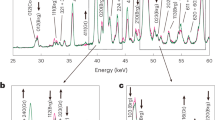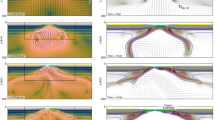Abstract
The strength of subducted slabs in the mantle transition zone influences the style of mantle convection. Intense deformation is observed particularly in relatively old subducted slabs in the deep mantle transition zone. Understanding the cause of this regional and depth variation in slab deformation requires constraint of the rheological properties of deep mantle materials. Here, we report results of in situ deformation experiments during the olivine to ringwoodite phase transformation, from which we infer the deformation process under the conditions of cold slabs deep in the mantle transition zone. We find that newly transformed fine-grained ringwoodite deforms by diffusion creep and that its strength is substantially smaller than that of coarser-grained minerals but increases with time. Scaling analysis, based on a model of transformation kinetics and grain-size evolution during a phase transformation, suggests that a cold slab will be made of a mixture of weak, fine-grained and strong, coarse-grained materials in the deep transition zone, whereas a warm slab remains strong because of its large grain size. We propose that this temperature dependence of grain size may explain extensive deformation of cold slabs in the deep transition zone but limited deformation of relatively warm slabs.
This is a preview of subscription content, access via your institution
Access options
Access Nature and 54 other Nature Portfolio journals
Get Nature+, our best-value online-access subscription
$29.99 / 30 days
cancel any time
Subscribe to this journal
Receive 12 print issues and online access
$259.00 per year
only $21.58 per issue
Buy this article
- Purchase on Springer Link
- Instant access to full article PDF
Prices may be subject to local taxes which are calculated during checkout



Similar content being viewed by others
Data availability
All data associated with this study are in the body of the manuscript and its Supplementary Information.
References
Fukao, Y., Obayashi, M., Nakakuki, T. & Group, D. S. P. Stagnant slab: a review. Annu. Rev. Earth Planet. Sci. 37, 19–46 (2009).
Karato, S., Riedel, M. R. & Yuen, D. A. Rheological structure and deformation of subducted slabs in the mantle transition zone: implications for mantle circulation and deep earthquakes. Phys. Earth. Planet. 127, 83–108 (2001).
Ringwood, A. E. Phase transformations and their bearings on the constitution and dynamics of the mantle. Geochem. Cosmochem. Acta 55, 2083–2110 (1991).
Rubie, D. C. The olivine -> spinel transformation and the rheology of subducting lithosphere. Nature 308, 505–508 (1984).
Sung, C. M. & Burns, R. G. Kinetics of olivine-spinel transition—implications to deep-focus earthquake genesis. Earth Planet. Sci. Lett. 32, 165–170 (1976).
Rubie, D. C. & Ross, C. R. Kinetics of the olivine–spinel transformation in subducting lithosphere—experimental constraints and implications for deep slab processes. Phys. Earth Planet. 86, 223–241 (1994).
Mohiuddin, A. & Karato, S. An experimental study of grain-scale microstructure evolution during the olivine–wadsleyite phase transition under nominally “dry” conditions. Earth Planet. Sci. Lett. 501, 128–137 (2018).
Riedel, M. R. & Karato, S. Microstructural development during nucleation and growth. Geophys. J. Int. 125, 397–414 (1996).
Riedel, M. R. & Karato, S. Grain-size evolution in subducted oceanic lithosphere associated with the olivine–spinel transformation and its effects on rheology. Earth Planet. Sci. Lett. 148, 27–43 (1997).
Girard, J., Amulele, G., Farla, R., Mohiuddin, A. & Karato, S. Shear deformation of a bridgmanite–magnesiowüstite aggregate under the lower mantle conditions. Science 351, 144–147 (2016).
Nishihara, Y. et al. Plastic deformation of wadsleyite and olivine at high-pressure and high-temperature using a rotational Drickamer apparatus (RDA). Phys. Earth Planet. 170, 156–169 (2008).
Durham, W. B., Weidner, D. J., Karato, S. & Wang, Y. in Plastic Deformation of Minerals and Rocks (eds S. Karato & H.-R. Wenk) 21–49 (Mineralogical Society of America, 2002).
Yamazaki, D. & Karato, S. High pressure rotational deformation apparatus to 15 GPa. Rev. Sci. Instrum. 72, 4207–4211 (2001).
Karato, S. Theory of lattice strain in a material undergoing plastic deformation: basic formulation and applications to a cubic crystal. Phys. Rev. B 79, 214106 (2009).
Matsui, M. et al. The temperature–pressure–volume equation of state of platinum. J. Appl. Phys. 105, 013505 (2009).
Nishihara, Y. et al. Thermal equation of state of (Mg0.91Fe0.09)2SiO4 ringwoodite. Phys. Earth Planet. 143, 33–46 (2004).
Singh, A. K., Balasingh, C., Mao, H. K., Hemley, R. J. & Shu, J. F. Analysis of lattice strains measured under nonhydrostatic pressure. J. Appl. Phys. 83, 7567–7575 (1998).
Ponge, D. & Gottstein, G. Necklace formation during dynamic recrystallization: mechanisms and impact on flow behavior. Acta Mater. 46, 69–80 (1998).
Handy, M. R. Flow laws for rocks containing two nonlinear viscous phases—a phenomenological approach. J. Struct. Geol. 16, 1727–1727 (1994).
Bina, C. R. Phase transition buoyancy contributions to stresses in subducting lithosphere. Geophys. Res. Lett. 23, 3563–3566 (1996).
Shimojuku, A. et al. Si and O diffusion in (Mg,Fe)2SiO4 wadsleyite and ringwoodite and its implications for the rheology of the mantle transition zone. Earth Planet. Sci. Lett. 284, 103–112 (2009).
Yamazaki, D., Inoue, T., Okamoto, M. & Irifune, T. Grain growth kinetics of ringwoodite and its implication for rheology of the subducting slab. Earth Planet. Sci. Lett. 236, 871–881 (2005).
Mosenfelder, J. L., Marton, F. C., Ross, C. R., Kerschhofer, L. & Rubie, D. C. Experimental constraints on the depth of olivine metastability in subducting lithosphere. Phys. Earth Planet. 127, 165–180 (2001).
Karato, S.-i. Deformation of Earth Materials: An Introduction to the Rheology of Solid Earth (Cambridge Univ. Press, 2008).
Argon, A. S. in The Inhomogeneity of Plastic Deformation (ed R. E. Reed-Hill) 161–189 (American Society of Metals, 1973).
Green, H. W. Solving the paradox of deep earthquakes. Sci. Am. 271, 64–71 (1994).
Sinogeikin, S. V., Bass, J. D. & Katsura, T. Single-crystal elasticity of γ-(Mg0.91Fe0.09)2SiO4 to high pressures and to high temperatures. Geophys. Res. Lett. 28, 4335–4338 (2001).
Hustoft, J. et al. Plastic deformation experiments to high strain on mantle transition zone minerals wadsleyite and ringwoodite in the rotational Drickamer apparatus. Earth Planet. Sci. Lett. 361, 7–15 (2013).
Miyagi, L. et al. Plastic anisotropy and slip systems in ringwoodite deformed to high shear strain in the rotational Drickamer apparatus. Phys. Earth Planet. 228, 244–253 (2014).
Karato, S., Paterson, M. S. & Fitz Gerald, J. D. Rheology of synthetic olivine aggregates: influence of grain-size and water. J. Geophys. Res. 91, 8151–8176 (1986).
Sung, C. M. & Burns, R. G. Kinetics of high-pressure phase-transformations—implications to evolution of olivine–spinel transition in downgoing lithosphere and its consequences on dynamics of mantle. Tectonophysics 31, 1–32 (1976).
van der Molen, I. & Paterson, M. S. Experimental deformation of partially-melted granite. Contrib. Mineral. Petr. 70, 299–318 (1979).
Karato, S. & Jung, H. Effects of pressure on high-temperature dislocation creep in olivine polycrystals. Philos. Mag. 83, 401–414 (2003).
Hirth, G. & Kohlstedt, D. L. in Inside the Subduction Factory (ed J. E. Eiler) 83–105 (American Geophysical Union, 2003).
Kawazoe, T., Karato, S., Otsuka, K., Jing, Z. & Mookherjee, M. Shear deformation of dry polycrystalline olivine under deep upper mantle conditions using a rotational Drickamer apparatus (RDA). Phys. Earth Planet. 174, 128–137 (2009).
Gripp, A. E. & Gordon, R. G. Current plate velocities relative to the hotspots incorporating the nuvel-1 global plate motion model. Geophys. Res. Lett. 17, 1109–1112 (1990).
Hosoya, T., Kubo, T., Ohtani, E., Sano, A. & Funakoshi, K. Water controls the fields of metastable olivine in cold subducting slabs. Geophys. Res. Lett. 32, L17305 (2005).
Kubo, T., Kaneshima, S., Torii, Y. & Yoshioka, S. Seismological and experimental constraints on metastable phase transformations and rheology of the Mariana slab. Earth Planet. Sci. Lett. 287, 12–23 (2009).
Acknowledgements
We thank H. Chen from 6BM-B beamline at Argonne National Laboratory for her help with the experiments (proposal ID: 52991) that are partly supported by COMPRES. We also thank K. Kisslinger from the Center for Functional Nanomaterials at Brookhaven National Laboratory for his help with TEM sample preparation and imaging. We are also grateful to Z. Jiang for his help with SEM and to W. Samella and C. Fiederlein for helping with preparation of parts for rotational Drickamer apparatus cell assembly. This work was supported by National Science Foundation grant no. EAR-1445356.
Author information
Authors and Affiliations
Contributions
A.M. and S.-i.K. conceived the idea of the experiment, and A.M. and S.-i.K. wrote the manuscript. A.M. and J.G. conducted the experiments, and A.M. analysed the data.
Corresponding author
Ethics declarations
Competing interests
The authors declare no competing interests.
Additional information
Peer review information Primary Handling Editors: Stefan Lachowycz; Melissa Plail.
Publisher’s note Springer Nature remains neutral with regard to jurisdictional claims in published maps and institutional affiliations.
Supplementary information
Supplementary Information
Supplementary discussions, Figs. 1–11, Table 1 and references.
Rights and permissions
About this article
Cite this article
Mohiuddin, A., Karato, Si. & Girard, J. Slab weakening during the olivine to ringwoodite transition in the mantle. Nat. Geosci. 13, 170–174 (2020). https://doi.org/10.1038/s41561-019-0523-3
Received:
Accepted:
Published:
Issue Date:
DOI: https://doi.org/10.1038/s41561-019-0523-3
This article is cited by
-
Resolving puzzles of the phase-transformation-based mechanism of the strong deep-focus earthquake
Nature Communications (2022)
-
Formation mechanisms of ringwoodite: clues from the Martian meteorite Northwest Africa 8705
Earth, Planets and Space (2021)
-
Dry metastable olivine and slab deformation in a wet subducting slab
Nature Geoscience (2021)



